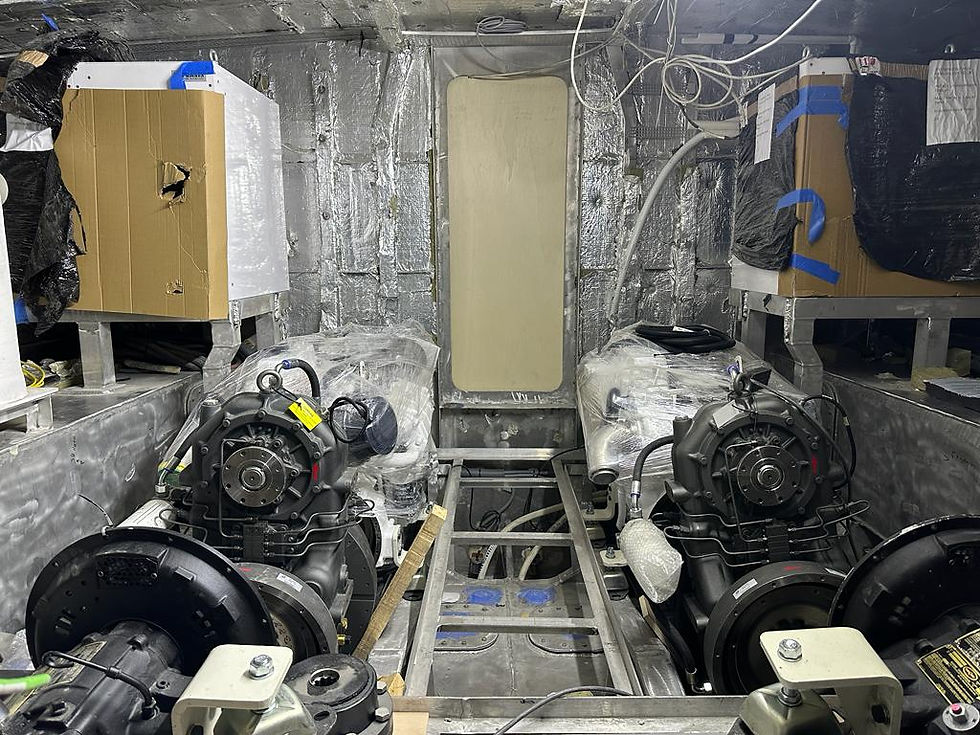Yacht Ventilation - Breaking the Traditional Yachting Mold
- Chris Leigh-Jones
- Jul 24, 2023
- 3 min read
Updated: Aug 6, 2023
Hello, fellow sea-lovers!
Today, we're peeling back the layers of traditional yachting design to explore an often underappreciated aspect–ventilation.
But we're not content to just simply go with the flow here; instead, we're forging our own path, rethinking how we approach climate control, air exchange, and humidity on our yacht, Vanguard.
We have a meeting today to finalize ventilation arrangements for the cabins.
In this instance, our scope of "Ventilation" is a mixture of climate control for temperature, humidity, and air exchange.
Established practice is a helpful guideline; looking at how other similar yachts achieve this shows strongly the influence of sailing yachts where the wind and conservation of precious battery capacity is everything.
Take Mobius, hull No 1 of the XPM 78 series. The main cabin has a hatch and dorade vents that can be sealed in inclement weather. Mobius also has a sizeable frontal scoop to supply air to the maim helm, saloon, and sliding panels on the flybridge to encourage air circulation.
Looking at the contemporaneous FPB-70 from Steve Dashew, she uses natural air circulation to encourage ventilation within the cabin and main helm with sliding panels on the flybridge to achieve similar.
These systems have their idiosyncracies and are supplemented by air scoops or other owner-designed additions. Their practical design is based on long experience sailing yachts worldwide.
Considering what we need
But here is the rub as we see it. We have a hybrid-powered yacht with a comparatively vast power storage capacity. Moreover, our ability to charge quickly is also relatively unheard of. My wife, Sebrina, comes from the Deep South of the USA. In this land, summers are 100 deg.C, and tumble dryers complete the washing. A comfortable work and living environment is more important than saving a liter of diesel. That about says it all, really.
Undoing Tradition
Suppose we start with the flybridge. We designed an open flybridge with the navigation console set back from the weather and direct sun. We will catch whatever breeze is available, and there is always shade. If it's super hot or cold, we will retreat to the saloon and aft deck, and besides this, I like feeling the elements.
In the saloon, we have added a side door at the helm station, so we now have a direct passive airflow path by opening both doors when conditions allow.
Now for a quick trieste on thermodynamics. From the starting point of humid air at 45 deg.C and the ending of air at 20 deg. An HVAC system will use as much energy to cool the air as it will dehumidify it. Now we have our guidelines.
On a short-handed vessel, the individual crew are either in the saloon or the cabins, but not both. So it is reasonable to surmise that fresh make-up air can be drawn from the saloon and pushed to the cabins when needed. We use make-up air twice but consume it only once.
So the design we have for Vanguard is a forced draft system.
Equipment for HVAC is the Webasto Blue Cool system and integrated controls.
We will take fresh outside air from the area of the flybridge, being as far from sea spray as we can get. We need a relatively small airflow as it represents make-up air sufficient to give (max) about ten air changes an hour for the volume of the saloon. We have duplicate in-line fans so that we can control the flow as needs be. The actual flow is controlled.
The saloon air will go through a continuous HVAC loop to adjust humidity and temperature. (In the case of heating the air, humidity is not considered).
All three cabins will draw their make-up air from the saloon. This will give the cabin HVAC a lighter workload as the air is pre-conditioned. Each cabin has its HVAC system that continuously conditions the cabin air. Air is constantly exhausted from the cabins through the heads. Drying towels and bathroom floors exhaust their moisture in the same direction.
A fan in each head operates when anyone is in the cabin or as otherwise instructed.
Clawing a little back
We can save some energy by:
Controlling the cabin extraction when occupied.
Using the pre-conditioned saloon air for the cabins with a passive flow system.
Using passive ventilation of the saloon and flybridge when weather permits.
My Southern Belle will be happy as she can have her cabin as cold as we can get without draining our batteries, and I got to "dweeb out" on the psychrometrics of it all, calculating the parameters only engineers care about.
Chris Leigh-Jones
I heard from our son Jeff this morning (right). He's been on a delivery run from Spain to Dartmouth, UK. I know that look of quiet enjoyment, magical. In his own words:" George and I have just crossed Biscay. Arrived in Dartmouth. Got lively approaching Ouessant so we headed north around the shipping lanes. Conquered the weather and felt alive with it all "















Comments